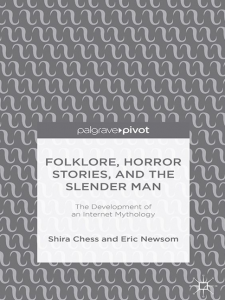 Since 2009, the Slender Man has been growing in popularity as an emergent, groundbreaking Internet horror myth. It entered the broader popular consciousness in May 2014, when two twelve year old girls led a third girl into a wooded area and stabbed her numerous times. The Slender Man takes on important cultural meanings in the age of the Internet – meanings often neglected when the crime version of the story went reported in the media. The revisions that they made to it helps to suggest an iterative folk telling tradition.
Since 2009, the Slender Man has been growing in popularity as an emergent, groundbreaking Internet horror myth. It entered the broader popular consciousness in May 2014, when two twelve year old girls led a third girl into a wooded area and stabbed her numerous times. The Slender Man takes on important cultural meanings in the age of the Internet – meanings often neglected when the crime version of the story went reported in the media. The revisions that they made to it helps to suggest an iterative folk telling tradition.
Folklore, Horror Stories, and the Slender Man: The Development of an Internet Mythology provides an in-depth analysis of the birth, iterations, implications, and interpretations of the Slender Man mythos. Because the Slender Man storytelling process is both crowd-sourced and participatory, interpretations are not static. Instead, the book acknowledges the shifting nature of Internet mythologies and how some versions become more privileged as primary even though the story lacks clear cannon. The book covers a range of important, interconnected topics that demystify the Slender Man: how the mythos was created, how meanings of the mythos reflect anxieties both old and new, how iterations reflect an open-source ethos, how the storytelling style varies by the specific “Digital Campfire” telling the story, and how the mythos both confirms and disrupts our understandings of fandom and fan fiction. The book is intended both to introduce new readers to the Slender Man and as contextualization of the importance of that myth to those who are already aware of it.
Shira Chess and Newsom
